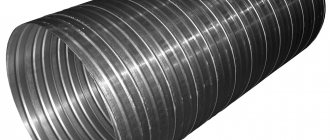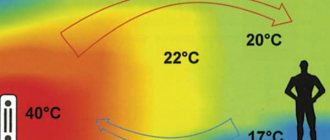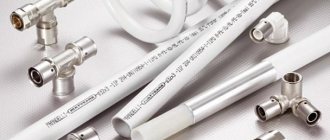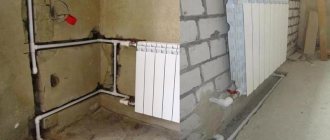How to calculate the diameter of a pipeline
The calculator is easy to use – enter the data and get the result. But sometimes this is not enough - accurate calculation of the pipe diameter is only possible with manual calculation using formulas and correctly selected coefficients. How to calculate the diameter of a pipe based on water flow? How to determine the size of a gas line?
Pipeline and necessary parts
When calculating the required pipe diameter, professional engineers most often use special programs that can calculate and produce accurate results based on known parameters. It is much more difficult for an amateur builder to carry out calculations independently to organize water supply, heating, and gasification systems. Therefore, most often when constructing or reconstructing a private house, the recommended pipe sizes are used. But not always standard advice can take into account all the nuances of individual construction, so you need to manually perform a hydraulic calculation in order to correctly select the diameter of the pipe for heating and water supply.
Two-pipe circuit in a private house
First, let's generalize a little. Let’s take, for example, calculating the diameter of polypropylene pipes for heating in a private house. Basically, products with a cross section of 25 mm are used for the circuit, and bends to radiators are set to 20 mm. Due to the fact that the size of the heating pipes in a private house, used as pipes to the batteries, is smaller, the following processes occur:
- the coolant speed increases;
- circulation in the radiator improves;
- The battery warms up evenly, which is important when connected at the bottom.
Combinations of a main circuit diameter of 20 mm and branches of 16 mm are also possible.
To verify the above data, you can calculate the diameter of pipes for heating a private house yourself. This will require the following values:
- square footage of the room.
Knowing the number of heated square meters, we can calculate the boiler power and what pipe diameter to choose for heating. The more powerful the heater, the larger the cross-section of the product that can be used in tandem with it. To heat one square meter of space, 0.1 kW of boiler power is required. The data is valid if the ceilings are standard 2.5 m;
- heat loss
The indicator depends on the region and wall insulation. The bottom line is that the greater the heat loss, the more powerful the heater should be. To get around the complex calculations that are not appropriate in the approximate calculation, simply add 20% to the boiler power calculated above;
- water speed in the circuit.
Allowed coolant speed is in the range from 0.2 to 1.5 m/s. Moreover, in most calculations of the diameter of pipes for heating with forced circulation, it is customary to take an average value of 0.6 m/s. At this speed, noise from friction of the coolant against the walls is eliminated;
- how much the coolant cools down.
To do this, subtract the return temperature from the supply temperature. Naturally, you cannot know the exact data, especially since you are at the design stage. Therefore, operate with average data, which are 80 and 60 degrees, respectively. Based on this, heat loss is 20 degrees.
Now the calculation itself is how to choose the diameter of the pipe for heating. To do this, let's take a formula that initially contains two constant values, the sum of which is 304.44.
Conditional flow of the circuit, squared = 304.44 x (area of the room x 0.1 kW + 20%) / heat loss of the coolant / flow rate.
The last step is to extract the square root of the result. For clarity, let’s calculate what pipe diameter to use for heating a private house with one floor with an area of 120 m2:
304.44 x (120 x 0.1 + 20%) / 20 / 0.6 = 368.328
Now let's calculate the square root of 368.328, which is equal to 19.11 mm. Before choosing the diameter of the heating pipe, we once again emphasize that this is the so-called conditional diameter. Products made from different materials have different wall thicknesses. For example, polypropylene has thicker walls than metal-plastic. Since we have knitted a polypropylene circuit as a sample, we will continue to consider this material. The marking of these products indicates the outer cross-section and wall thickness. Using the subtraction method, we find out the size we need and select it in the store.
The ratio of the outer and inner diameter of polypropylene pipes
For convenience, we will use the table.
Based on the results of the table, we can conclude:
- if a nominal pressure of 10 atmospheres is sufficient, then an outer section of the heating pipe of 25 mm is suitable;
- if a nominal pressure of 20 or 25 atmospheres is required, then 32 mm.
Calculation of pipe diameter for water supply and heating
The main criterion for selecting a heating pipe is its diameter. This indicator determines how effective the heating of the house will be and the service life of the system as a whole. With a small diameter, increased pressure may occur in the lines, which will cause leaks, increased load on pipes and metal, which will lead to problems and endless repairs. With a large diameter, the heat transfer of the heating system will tend to zero, and cold water will simply ooze out of the tap.
Pipe capacity
The diameter of the pipe directly affects the throughput of the system, that is, in this case, what matters is the amount of water or coolant passing through the section per unit time. The more cycles (movements) in the system over a certain period of time, the more efficient the heating is. For water supply pipes, the diameter affects the initial water pressure - a suitable size will only maintain the pressure, and an increased one will reduce it.
The diameter of the water supply and heating system, the number of radiators and their sections are selected, and the optimal length of the lines is determined.
Since the throughput of the pipe is a fundamental factor in the choice, you should decide what, in turn, affects the throughput of water in the main.
Table 1. Pipe capacity depending on water flow and diameter
| Consumption | Bandwidth | ||||||||
| Du pipe | 15 mm | 20 mm | 25 mm | 32 mm | 40 mm | 50 mm | 65 mm | 80 mm | 100 mm |
| Pa/m - mbar/m | less than 0.15 m/s | 0.15 m/s | 0.3 m/s | ||||||
| 90,0 — 0,900 | 173 | 403 | 745 | 1627 | 2488 | 4716 | 9612 | 14940 | 30240 |
| 92,5 — 0,925 | 176 | 407 | 756 | 1652 | 2524 | 4788 | 9756 | 15156 | 30672 |
| 95,0 — 0,950 | 176 | 414 | 767 | 1678 | 2560 | 4860 | 9900 | 15372 | 31104 |
| 97,5 — 0,975 | 180 | 421 | 778 | 1699 | 2596 | 4932 | 10044 | 15552 | 31500 |
| 100,0 — 1,000 | 184 | 425 | 788 | 1724 | 2632 | 5004 | 10152 | 15768 | 31932 |
| 120,0 — 1,200 | 202 | 472 | 871 | 1897 | 2898 | 5508 | 11196 | 17352 | 35100 |
| 140,0 — 1,400 | 220 | 511 | 943 | 2059 | 3143 | 5976 | 12132 | 18792 | 38160 |
| 160,0 — 1,600 | 234 | 547 | 1015 | 2210 | 3373 | 6408 | 12996 | 20160 | 40680 |
| 180,0 — 1,800 | 252 | 583 | 1080 | 2354 | 3589 | 6804 | 13824 | 21420 | 43200 |
| 200,0 — 2,000 | 266 | 619 | 1151 | 2486 | 3780 | 7200 | 14580 | 22644 | 45720 |
| 220,0 — 2,200 | 281 | 652 | 1202 | 2617 | 3996 | 7560 | 15336 | 23760 | 47880 |
| 240,0 — 2,400 | 288 | 680 | 1256 | 2740 | 4176 | 7920 | 16056 | 24876 | 50400 |
| 260,0 — 2,600 | 306 | 713 | 1310 | 2855 | 4356 | 8244 | 16740 | 25920 | 52200 |
| 280,0 — 2,800 | 317 | 742 | 1364 | 2970 | 4356 | 8566 | 17338 | 26928 | 54360 |
| 300,0 — 3,000 | 331 | 767 | 1415 | 3076 | 4680 | 8892 | 18000 | 27900 | 56160 |
What is needed for the calculation?
To calculate the diameter of the pipes, you need to know the thermal power required to heat each room. Surely it was already determined during the selection of the boiler installation, but if not, then approximately the amount of heat can be calculated by the volume of the room. This is done simply: for each cubic meter of room you need to put 40 W of heat, then the heat consumption will be equal to the volume multiplied by 40, the result will be in Watts.
Next, you should decide on the type of heating system by choosing one of the two existing ones:
- single-pipe;
- two-pipe.
Two-pipe systems in a private house are preferable and are more popular, although single-pipe systems also have a right to exist. It should be noted that the laws of fluid movement are the same both in a one-pipe system and in a two-pipe system, therefore this issue is not very important for finding the diameters of the mains. Of much greater interest is the method of moving the coolant, of which there are also two:
- convection, occurring due to the difference in weight of hot and cooled water (gravity-flow systems);
- forced, when the coolant is forced to move by a circulation pump.
The difference between these two methods is that in the first case, the liquid passes through the pipes slowly, and in the second, under the action of a pump, much faster. The speed of the coolant is one of the most important parameters involved in the calculation; the throughput of the main line depends on it. The recommended speed range is from 0.3 to 0.7 m/s. When a heating system with forced circulation is planned, this value can be taken equal to 0.7 m/s, and with gravity - 0.3 m/s.
If the water speed is below the specified limit, air bubbles will appear in it, and the pipe size will be too large and economically unjustified. If the speed is high, noise will appear in the pipelines and the hydraulic resistance of the entire network will sharply increase; a standard circulation pump may not be able to cope with it.
Calculation of pipe diameter based on water flow
Determining the correct water flow
To determine the diameter of the pipe based on the flow rate of the passing liquid, you will need the values of the true water consumption, taking into account all plumbing fixtures: bathtub, kitchen faucet, washing machine, toilet. Each individual section of the water pipeline is calculated using the formula:
where qc is the value of water consumed by each device;
q0 is a standardized value, which is determined according to SNiP. We take for a bath - 0.25, for a kitchen faucet 0.12, for a toilet -0.1;
a is a coefficient that takes into account the possibility of simultaneous operation of plumbing fixtures in the room. Depends on the probability value and the number of consumers.
In sections of the main line where water flows for the kitchen and bath, for the toilet and bath, etc. are combined, a probability value is added to the formula. That is, the possibility of simultaneous operation of a kitchen faucet, bathroom faucet, toilet and other appliances.
The probability is determined by the formula:
Р = qhr µ × u/q0 × 3600 × N,
where N is the number of water consumers (appliances);
qhr µ is the maximum hourly water flow that can be accepted according to SNiP. For cold water we select qhr µ =5.6 l/s, total flow rate 15.6 l/s;
u – number of people using plumbing fixtures.
Example of calculating water consumption:
The two-story house has 1 bathroom, 1 kitchen with installed washing machine and dishwasher, shower, 1 toilet. A family of 5 lives in the house. Calculation algorithm:
- We calculate the probability P = 5.6 × 5/0.25 × 3600 × 6 = 0.00518.
- Then the water consumption for the bathroom will be qc = 5 × 0.25 × 0.00518 = 0.006475 l/s.
- For the kitchen qc = 5 × 0.12 × 0.00518 = 0.0031 l/s.
- For a toilet, qc = 5 × 0.1 × 0.00518 = 0.00259 l/s.
Calculate the pipe diameter
There is a direct relationship between the diameter and the volume of flowing liquid, which is expressed by the formula:
where Q is water flow, m3/s;
d – pipeline diameter, m;
w – flow velocity, m/s.
By transforming the formula, you can select the value of the pipeline diameter, which will correspond to the consumed volume of water:
Yulia Petrichenko, expert
The water flow rate can be taken from Table 2. There is a more complex method for calculating the flow rate - taking into account losses and the coefficient of hydraulic friction. This is a rather voluminous calculation, but in the end it allows you to get an accurate value, unlike the tabular method.
How to calculate the diameter of a gas pipe
A gas pipe is calculated slightly differently than a water pipe. Here the fundamental values are:
- gas speed and pressure;
- pipe length with pressure loss on fittings;
- pressure drop is within acceptable limits.
The diameter of the gas pipe can be calculated using the formula:
where di is the internal diameter of the pipeline, m;
V´—volume flow rate of compressed air, m³/s;
L—pipeline length adjusted for fittings, m;
Δp — permissible pressure drop, bar;
pmax - upper compressor pressure, bar.
Thus, when choosing a pipe diameter, an important parameter is the throughput, which depends on the cross-section and internal size of the line. Therefore, it is necessary to compare such data as permissible pressure, wall thickness, internal diameter of the pipe, properties of the coolant or gas.
How do you select the size of the pipeline? Tell us, what parameters did you use to calculate the pipes for your own home?
Source
Calculation procedure
You need to start calculating the diameter of a heating pipe by drawing a diagram. It is necessary to draw a plan of each floor of the building and reflect on it all branches of the system. This is all done in the form of a sketch, by hand, and to make it easier for you to understand, take a larger sheet of paper. When the diagram is ready, imagine an abstract picture where hot water from the boiler spreads through the pipelines and carries heat with it to each room. So, our pipes must pass enough of this water so that there is enough heat for each room.
The purpose of the calculation is to find out the coolant flow and the throughput of the mains, comparing it with standard pipe diameters.
We start counting from the farthest room, where the heating system dead end is located. The mass flow rate of the coolant is determined by the formula:
G = 0.86 Q / Δt , where:
- G – desired mass flow rate of water, kg/h;
- Q – amount of heat required to heat the room, W;
- Δt – temperature difference in the supply and return pipelines, in calculations is always taken equal to 20 ºС.
We have determined the mass of liquid flowing into our room, and in order to select the desired pipe diameter, we need to know its volume. Since water is hot with a maximum temperature of 80 ºС, its density is less, which means that it is necessary to calculate the volumetric flow rate (l/h), dividing the mass by the density:
V = G/ρ
For reference. The density of water at a temperature of 80 ºС is 971.6 kg/m3.
Knowing the volume of flowing coolant, we can calculate the cross-sectional area:
A = V / (3600ϑ)
In this formula:
- A – pipe cross-sectional area, m2;
- V – volumetric flow rate of coolant, m3/h;
- ϑ – speed of water movement, m/s.
Further, the diameter of metal-plastic pipes for heating, as well as heat pipes made of other materials, is calculated using the formula for the area of a circle:
D = √ 4A / π
Example. 3000 W of heat must be supplied to the far room; the circulation of the coolant is natural. The mass flow will be 0.86 x 3000 / 20 = 129 kg/h, the volume flow will be 129 / 971.6 = 0.13 m3/h. The cross-sectional area of the pipe will be: 0.13 / (3600 x 0.3) = 0.00012 m2, and its diameter will be √4 x 0.00012 / 3.14 = 0.012 m or 12 mm.
We put the resulting figure on the diagram near the far room and move on to the next one, which is closer to the boiler. We perform the same calculations in it, but we need to take into account the fact that heat for both rooms is supplied through one pipe. Therefore, first you need to add up the thermal power for heating these two rooms, and substitute the result into the first formula for calculating the mass flow rate of the coolant. At the end, we move even closer to the boiler, adding up the heat for 3 rooms and so on.
If the described method seems cumbersome to someone, then the choice of the diameter of the heating pipes is made using ready-made tables. However, often the information presented in them is incomplete or is given in such a form that it is difficult for the average homeowner to understand the numbers. Here is one such table:
As you can see, the calculated diameters are presented here with a certain interval, although the standard series of internal dimensions is in this order: DN 10, 15, 20, 25, 32, 40, 50 and so on. By the way, it is clearly noticeable how the pipes for heating with natural circulation are larger in diameter than when the system has a circulation pump. To verify this, it is enough to compare the throughput of any pipe size at a coolant speed of 0.3 and 0.7 m/s.
Having received the results, we select a pipe by size from the standard range, taking the nearest larger diameter. It should be taken into account that the designation of steel water and gas pipes indicates the internal size of the product, while in electric welded pipes the external size is indicated. Metal-plastic, polyethylene and polypropylene pipes have the same markings, so to determine the internal diameter, you need to subtract 2 wall thicknesses from the external dimensions.
Making calculations manually is not always convenient; the process takes a lot of time. To simplify the work, it is recommended to enter the 4 simple formulas outlined above into Excel and perform calculations using this program. Then you will be confident in the results obtained and will know exactly which pipes should be used for heating.
Dependence of water pressure on pipeline diameter
There is a direct relationship between the pressure of the water flow and the pipe diameter, described by Bernoulli's law.
When passing a constant water flow through pipes with different cross-sections, it is found that
in the narrow parts the pressure is less than in the wide ones .
When water moves from a wide part to a narrow part, the pressure decreases, and vice versa.
In pipes with different cross-sections, an equal volume of water flows in the same period of time. Therefore, in wide areas it flows slower than in narrow ones .
Ratio table
Water consumption directly depends on throughput. This is a value that shows the maximum volume passing through the system over a certain time period and at a certain pressure.
For pipes with different diameters, this value varies. Details are shown in the table below:
Step-by-step instructions on how to calculate water consumption
You can make calculations using tables. But the results obtained will be inaccurate. Therefore, it is better to carry out calculations on site, taking into account the flow rate, the material of the piping systems and other characteristics of the pipeline.
The easiest way is to calculate the amount of H2O consumed using the following formula:
- q – water consumption (l/s);
- V – flow velocity (m/s);
- d – diameter (cm).
This formula can also be used to search for other unknowns. If the diameter and flow rate of the water are known, the flow rate can be determined. And if V and q are known, you can find out the diameter.
In most risers, the water flow pressure is 1.5-2.5 atmospheres . And the flow speed is usually 0.8-1.5 m/s. An additional supercharger can be installed, which changes the parameters within the system. All data about it must be indicated in the registration certificate.
The minimum pressure in the system should be 1.5 atmospheres - this is enough to operate a washing machine and dishwasher. The higher it is, the faster the water moves through the pipes, so water consumption increases.
To obtain more accurate results, the Darcy-Weisbach formula is used, which takes into account possible changes in water pressure, which leads to an increase or decrease in pressure.
- ΔP – pressure loss due to flow resistance;
- λ – friction loss indicator along the entire length;
- D – pipe section;
- V—flow velocity;
- L – pipeline length;
- g – constant = 9.8 m/s2;
- ϸ is the flow viscosity.
This formula is usually used to perform complex fluid dynamics calculations. In other cases, simplified options are used.
A special case of calculating water flow is through the tap opening. The formula used is:
- Q – water consumption;
- S – area of the circle (faucet opening), determined by the formula S= π*r2;
- V is the flow velocity; if it is unknown, it can be determined based on the formula V=2g*h, where g is a constant, h is the height of the water column above the tap opening.
Calculation rules
When performing calculations, the following rules must be taken into account:
Make sure the values are correct. If one value is calculated in m/s, then the other must be measured in l/s (not kg/hour). Otherwise, the calculations made will be incorrect.- Use correct constant values.
- Observe the data of the system supercharger, if used. All information about its influence on the system parameters is indicated in the technical data sheet.
- It is recommended to carry out intermediate calculations with exact values, and the final result can be rounded (preferably up).
To make calculations easier, you can use online calculators, in which you just need to enter all the known data.
Formulas
Because you and I, dear reader, are not encroaching on obtaining a diploma as a heating engineer, we are not going to get into the weeds.
A simplified calculation of the diameter of the heating pipeline is performed using the formula D=354*(0.86*Q/Dt)/v, in which:
- D is the desired diameter value in centimeters.
- Q is the thermal load on the corresponding section of the circuit.
- Dt is the temperature delta between the supply and return pipelines. In a typical autonomous system it is approximately 20 degrees.
- v is the coolant flow rate in the pipes.
It looks like we don't have enough data to continue.
In order to calculate the diameter of heating pipes, we need:
- Find out how fast the coolant can move.
- Learn to calculate the thermal power of the entire system and its individual sections.
Coolant speed
It must meet a couple of boundary conditions.
On the one hand, the coolant must circulate in the circuit approximately three times per hour. In another case, the coveted temperature delta will increase noticeably, making the heating of the radiators uneven. In addition, in severe cold weather we will take full advantage of the real possibility of defrosting the coolest sections of the circuit.
Otherwise, excessively high speed will generate hydraulic noise. Falling asleep to the sound of water in the pipes is, let’s say, not an acquired taste.
The acceptable range of flow rates is from 0.6 to 1.5 meters per second; Along with this, in calculations in most cases the maximum permissible value is used - 1.5 m/s.
Thermal power
Here is a diagram of its calculation for the normalized thermal resistance of walls (for the center of the country - 3.2 m2 * C / W).
- For a private home, the basic power is 60 watts per cubic meter of room.
- To these are added 100 watts for each window and 200 for each door.
- The result is multiplied by a regional coefficient depending on the climatic territory:
| Average January temperature | Coefficient |
| -40 | 2,0 |
| -25 | 1,6 |
| -15 | 1,4 |
| -5 | 1 |
| 0 | 0,8 |
Thus, a room with a volume of 300 m2 with three doors and windows in Krasnodar (average temperature in January is +0.6 C) will require (300 * 60 + (3 * 100 + 200)) * 0.8 = 14800 watts of heat.
For buildings whose thermal resistance of walls differs significantly from the normalized one, another simplified scheme is used: Q=V*Dt*K/860, where:
- Q is the thermal power requirement in kilowatts.
- V is the amount of heated space in cubic meters.
- Dt is the temperature difference between the street and the room at the peak of cold weather.
Useful: it is better to take the temperature in the room to correspond to sanitary standards, and the outside temperature to the average minimum over the last couple of years.
- K is the building insulation coefficient. Where do you get its values from? The instructions will be found in the next table.
| Insulation coefficient | Description of enclosing structures |
| 0,6 — 0,9 | Foam or mineral wool coat, insulated roof, energy-saving triple glazed windows |
| 1,-1,9 | One and a half brick masonry, single-chamber double-glazed windows |
| 2 — 2,9 | Brickwork, windows in wood frames without insulation |
| 3-4 | Half-brick masonry, single-strand glazing |
Where to get the load for a separate section of the circuit? It is calculated based on the volume of the room that is heated by this area using one of the above methods.











